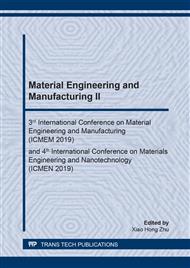p.31
p.38
p.42
p.50
p.55
p.62
p.71
p.77
p.84
Anti-Cavitation Approach in a Bio-Inspired Throttle Valve: A Study of Using Rubber-Like Materials
Abstract:
This multiscale molecular study emphasizes on reducing cavitation in a squid - inspired throttle valve. Molecular simulations on 10 different polymers bonded layer-wise to Iron (III) Oxide were done and the 5 ones having the strongest binding energies were further relaxed using xenon crystals (0.2ns). Changes in the radius of gyration were observed and post relaxation, the interaction energy, the cohesive energy density, and the Hildebrand solubility parameter of the polymer-water layer were determined. Consequently, Polytetrafluoroethylene (PTFE) chosen from the results was further equilibrated for 1.05 ns. To verify its wettability, a contact angle (water nanodroplet) of 115° was estimated. Next, the lined (3mm thick PTFE) valve seat of the chosen throttle valve was numerically analyzed. The computational fluid dynamics (CFD) code, ANSYS Fluent 17.0 was used to test the 3D model with assigned boundary conditions to determine the vapor fraction and the static pressure. Finally, thickness optimization of the lining was done to improve the valve’s performance within the fluid power system and minimize cost involvement.
Info:
Periodical:
Pages:
55-61
Citation:
Online since:
January 2020
Authors:
Price:
Сopyright:
© 2020 Trans Tech Publications Ltd. All Rights Reserved
Share:
Citation:


